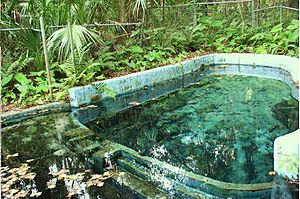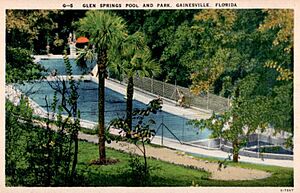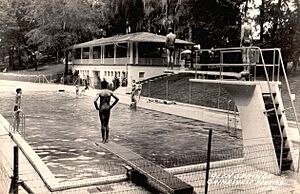Glen Springs facts for kids
Quick facts for kids Glen Springs |
|
|---|---|

head spring
|
|
| Lua error in Module:Location_map at line 420: attempt to index field 'wikibase' (a nil value). | |
| Type | Former Recreation Area |
| Location | Gainesville, Florida |
| Area | 3.79 acres (1.53 ha) |
| Created | 1924-1926; 1940 |
| Designer | Guy Fulton |
| Owned by | Elks Club of Gainesville |
| Open | yearly fishing derby |
| Status | closed |
Glen Springs is a natural spring located in Gainesville, Florida. It was once a very popular place for swimming and fun, but it closed to the public in 1970. Today, it is no longer used for swimming.
Contents
History of Glen Springs
People in Gainesville have known about Glen Springs since the city was founded in 1854. They loved visiting this beautiful spring surrounded by trees. Water from the spring flows into a stream called Glen Spring Run, which then joins Hogtown Creek. In the past, a lot of water flowed from the spring, but today, less water comes out.
Early Days and the Pound Family
In 1924, a businessman named Cicero Addison Pound Sr. bought the land around the spring. He hired an architect named Guy Fulton to design a pool and a building called a springhouse. These were built soon after. The swimming team from the University of Florida even practiced there around 1929!
At that time, Glen Springs was the only public place to swim near Gainesville. However, it was a segregated swimming area. This meant only white people were allowed to swim there.
In 1940, the swimming area was made even bigger. It grew to have three pools!
- The first pool held the spring itself. It was about 18 feet by 10 feet and 8 feet deep.
- The middle pool was 170 feet by 25 feet and 3 feet deep.
- The last pool was 140 feet by 25 feet and 8 feet deep.
Together, these pools held over 300,000 gallons of water! There were also diving boards, one meter and three meters high.
The springhouse had two levels. Downstairs, there were locker rooms and showers. Upstairs, there was a wooden dance floor, a jukebox for music, and a snack bar. The person who managed the facility for 20 years called it "the largest baby-sitting agency in Gainesville." The pools were cleaned every week. Workers would drain the water and scrub the walls and bottom. Then, the pools would refill with fresh spring water.
Glen Springs was a popular spot for many activities. Families had picnics, kids had birthday parties, and Boy and Girl Scouts visited. There were also swimming lessons and special events like a traveling carnival and a mermaid show! You could even rent the facility for private parties at night.
Famous musician Tom Petty, who grew up in Gainesville, mentioned Glen Springs in his song, "Dreamville": Ridin' with my mama
To Glen spring's pool
The water was cold
My lips were blue
The Elks Club Takes Over
In 1970, new rules were made about water. The city said that chlorinated water (water with cleaning chemicals) could not be put into the local creeks. Also, other swimming pools had opened in Gainesville. Because of these reasons, Glen Springs pool closed.
The Elks Lodge #990 bought the property. They did not allow swimming anymore. The Elks built a deck on the springhouse, but they did not fix up the pools. Over the years, the old pools have fallen apart. The Elks Club now uses the pools for fishing. They put fish like bluegills and catfish in them and hold an annual fishing derby.
In 1984, a professor named A.O. White tried to get the city to buy the spring. He wanted to make it a natural area again. The Elks Club and the city talked about it for a few years, but they could not agree on a price. The Elks did not want to sell.
Around 1995, the city bought land next to Glen Springs. This land became the Alfred A. Ring Park. A bridge was built over the Glen Springs Run, and the area around the stream was made more natural. People who visit Alfred A. Ring Park can use the Elks Club parking lot.
Future Plans for Glen Springs
In 2010, a student named Amy Grossman found out about Glen Springs. She was sad to see how run-down it was. For a class project, she decided to create a plan to bring Glen Springs back to life. Her teacher, Dr. Robert L. Knight, liked the idea. Dr. Knight also worked at the Florida Springs Institute.
The plan, called the Glen Springs Restoration Plan, aimed to:
- Show how important the spring is.
- Share its history.
- Point out the problems it faces today.
- Suggest ways to fix those problems.
Different groups helped with this plan. The Wildlife Foundation of Florida gave money. Wetland Solutions, Inc. provided technical help. The Howard T. Odum Florida Springs Institute (FSI) shared the report with others.
In 2012, the plan was updated with new information and pictures. The Florida Springs Institute started working with some Elks Club members to improve Glen Springs. If the site could be listed on the National Register of Historic Places, it would be easier to get money for restoration. The Elks want to keep the pool, but the FSI wants to make the spring more natural.
On April 21, 2012, the Elks Club held a cleanup day. Volunteers helped clean the pools by removing algae and debris. In May 2012, Dr. Knight asked the city for support. The city is waiting to see what happens with the private efforts before they decide to help with the plan.




